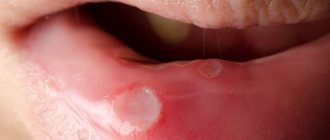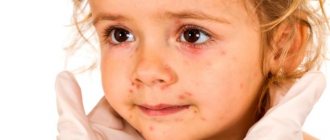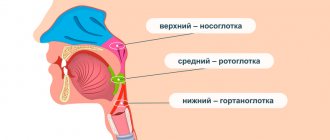According to statistics, more than 80% of parents are faced with such an unpleasant disease in their child as stomatitis. Some people think that this is a harmless disease. Moreover, if treatment is not started on time, this will lead to complications and an increase in the duration of therapy.
Stomatitis is the general name for a disease that manifests itself in the form of ulcers on the oral mucosa. It can form on the roof of the mouth, gums, tongue, cheeks and even in the lips. Among the reasons for this occurrence are the following:
- mucosal injury;
- diseases of the gastrointestinal tract;
- poor oral hygiene;
- entry of bacteria.
Due to the fact that with any type of stomatitis the integrity of the mucosal epithelium is disrupted, in children the symptoms look the same: the formation of plaque, erosions and ulcers, redness, pain, bad breath, swelling.
Types of diseases that most often occur in young patients:
- candidiasis - infants are often susceptible to this variety. The reason is the active proliferation of the fungus of the genus Candida. A white “curdled” coating appears in the oral cavity;
- aphthous - small reddish ulcers appear;
- herpetic - characterized by a large number of rashes that are filled with liquid. They combine and turn into erosion with a white coating;
- angular - when jams appear in the corners of the lips.
Viral stomatitis
Another type of disease that usually affects children under 4 years of age. This is a complex infectious disease that causes a lot of pain for the child. In almost 100% of cases, it will be transmitted to the baby from parents or loved ones. There are several reasons for its occurrence:
- recent infectious disease: herpes, influenza, chickenpox;
- interaction with a sick person, because this type of disease is transmitted by airborne droplets and through objects;
- low immunity.
Many people are interested in: what does this type of stomatitis look like in children? Most often, the baby develops herpes. Multiple aphthae with a yellow or white tint form in groups in the oral cavity. Experts explain this by saying that children are most sensitive to this type of virus due to the lack of antibodies in their bodies. If someone close to you suffers from such a disease, then the likelihood of its occurrence in a child increases several times.
Symptoms:
- the child is lethargic, capricious, nervous;
- the temperature may rise and weakness may appear;
- pain appears, which is also possible in the area of the submandibular lymph nodes;
- bad breath;
- If you examine the oral cavity, you will notice swelling of the gums and aphthae, which are covered with a whitish film.
If any of the symptoms appear, you should consult a doctor immediately, because... Viral stomatitis in the initial stages is very similar to a sore throat. Only a specialist can make an accurate diagnosis, so you need to forget about self-medication. In addition, this will determine how long the treatment will last and how quickly the symptoms will go away.
Symptoms and signs of sore throat
In adults
- Temperature increase.
- Inflammation of the oral cavity.
- Lack of appetite.
- White coating in the mouth.
- A sore throat.
- Severe malaise.
- Muscle aches.
- Ulcerative lesions of the oropharynx, lips.
- Swollen, reddened tonsils, purulent formations on them.
- Blood in saliva when it is secreted abundantly.
- Runny nose.
- Hypertrophy of lymph nodes.
- Cough.
How to distinguish a viral sore throat from a bacterial one
In children
Young children quite often get stomatitis sore throat. The disease occurs in a more severe and dangerous form than in adults, and therefore requires hospital treatment. In addition to the above symptoms:
Treatment
In addition to the day after the discovery of symptoms, the parents went to the doctor, important factors for drawing up the correct therapy are the age and immunity of the child. In general terms, the course of treatment will be as follows.
- Rinse.
The dentist prescribes anti-inflammatory drugs that are used to treat the mucous membrane daily. For children, you can also prepare decoctions of calendula or chamomile.
- Use of medications.
After rinsing, the sores are usually treated with ointments or oils, as well as antiviral ones. To do this, you can use and constantly change cotton swabs.
- Antipyretic and painkillers.
If there is an elevated temperature and severe pain, the doctor may prescribe appropriate medications.
If all recommendations are followed and depending on the severity of the disease, therapy can last up to several weeks. Parents need to remember that self-treatment can only worsen the situation. The doctor will not only prescribe an effective treatment, but most importantly, correctly determine the type of disease.
Medications
Comprehensive treatment includes taking antiviral medications. Bonaferon has proven itself to be excellent (take for 5 days). In order to remove toxins and strengthen the immune system, you need to take antihistamines - Suprastin, Diphenhydramine, as well as calcium supplements. Specialists additionally prescribe medications that contain prodigiosan, as well as injections of Lysozyme. The acute form is treated only with antibiotics.
So, sore throat and stomatitis are unpleasant ailments that lead to various complications, which is why it is so important to take timely measures
Prevention measures
To reduce the likelihood of developing stomatitis in a child, specialists at a family dentistry clinic in Moscow recommend:
- regularly wash and treat toys, bottles and other items that the baby uses;
- strengthen immunity;
- maintain a balanced diet that contains vitamins and minerals;
- treat diseases of the gastrointestinal tract, as well as colds and flus in a timely manner;
- Visit your dentist regularly for preventive examinations.
Such simple tips will help you avoid more serious consequences of the disease or even minimize its occurrence.
Stomatitis sore throat - description, treatment, symptoms
Published by Mister Doctor on 02/24/2019
Stomatitis sore throat is an infectious disease, it seems to be a complex phenomenon, since it is formed by mixing two backgrounds of different diseases - inflammation of the palatine zone and stomatitis manifestation. The disease is characterized by similar symptoms of tonsillitis and the appearance of painful “nodules”, so it is often difficult to recognize the secretive nature of the inflammatory process. As a rule, the disease manifests itself in the detection of wounds of an ulcerative nature, then the characteristic symptoms of a common sore throat begin.
The inflammatory process, accompanied by the appearance of stomatitis formations, as well as redness of the throat, soreness, swollen tonsils, is complex; it is necessary to exclude the “neglectedness” of the process in order to avoid even greater complications. Ulcerative formations on the tonsils cause acute pain and difficulty swallowing, so you should not delay medical help.
Diagnosis of stomatitis sore throat
If stomatitis sore throat occurs, the doctor’s diagnosis is able to quickly recognize the presence of an infectious disease. The procedure for identifying the disease does not require complex measures. In addition to a visual examination of the throat and studying the obvious picture of the course of the disease, other diagnostic measures are carried out. They are carried out in the following stages:
- Additional research is necessary - the doctor will definitely prescribe a blood test.
- You will need to take a throat swab to determine the microorganisms that predominate in the body.
- Sometimes serological study methods are necessary to recognize an infection that has settled in the body (for example, the presence of herpes).
If the diagnosis is confirmed, effective steps to eliminate the disease should be outlined, approaching the issue responsibly and thoroughly to avoid complications.
Stomatitis and sore throat at the same time, what to do?
Quite often, a sore throat is accompanied by stomatitis, an inflammatory process of the oral mucosa. Infection begins precisely from stomatitis, after which symptoms of sore throat appear.
The disease occurs because immunity decreases after influenza or ARVI. With stomatitis and tonsillitis caused by herpes, erosions form on the mucous membrane and plaque appears.
How dangerous are the diseases? How to treat them?
Symptoms
A person becomes infected with stomatitis when he comes into contact with a sick person. The disease develops gradually - sometimes it takes several days or even weeks. The disease develops acutely - the temperature rises sharply, the person weakens, and pain appears in the oral cavity.
One of the main signs of stomatitis sore throat is ulcers and plaque on the tonsils. Experts are confident that the disease is caused by pathogenic bacteria that lead to stomatitis. Pathologies develop in the tonsils, as well as in the oral mucosa. The plaque may be white or yellow, and ulcers begin to form under the film.
Particularly dangerous is the acute form of tonsillitis, which is accompanied by high fever, severe pain - it is impossible to swallow food, it is difficult to drink drinks, and salivation also increases.
Sometimes the lymph nodes begin to noticeably enlarge and are painful to touch. A blood test shows an increased number of white blood cells. As a rule, the disease lasts about two weeks. If the disease is advanced, more time is needed.
Who is most likely to get sick?
Tonsillitis and stomatitis most often affect a weak body. Most often, the pathology is diagnosed in people with low immunity. The disease affects an exhausted body and develops with dystrophy. The problem can also be caused by periodontal disease.
Treatment methods
In addition to standard therapy, it is imperative to treat mouth ulcers to prevent the infection from spreading. Carefully approach the treatment of your baby, otherwise everything may end up in a chronic form.
Try to gargle with antiseptics and herbal decoctions
It is very important that the patient adheres to a diet and stays in bed. In the menu, include finely chopped food, freshly squeezed juice, which will not irritate the mucous membranes
To help your body recover faster, take vitamins. In cases where the patient experiences unbearable pain, medications containing Pyramidon are prescribed. Additionally, Penicillin is administered intramuscularly. To alleviate the condition, it is necessary to treat the affected mucous membrane of the tonsils and mouth with various drugs. To prevent the disease from recurring, antibiotics are necessary.
The difference between stomatitis and sore throat
Diseases differ in symptoms! With a sore throat, it is difficult for a patient to swallow food, but with an inflammatory process, irritation appears in the oral mucosa.
Localization is considered a distinctive feature. With tonsillitis erosion, plaque forms on the tonsils. But with stomatitis, bacteria begin to infect the oral mucosa and lips.
Acute stomatitis is practically no different from a sore throat. Especially when the infection is caused by herpes. As a rule, this disease is typical for children under 3 years of age. It takes a lot of time to cure a disease
It is important to undergo comprehensive treatment so that the immune system has time to fully recover
Diagnostics
You should not self-medicate; it is best for a doctor to prescribe a course of therapy. For diagnostic purposes, immunological and cytological studies are used, and the oral cavity is carefully examined. Complex treatment makes it possible to find out the cause of the disease, then select the necessary medications.
Do not start pathology, otherwise everything will end in serious consequences. Inadequate treatment will lead to serious consequences and further complicate the disease. Everything can end in serious and unpleasant consequences.
Medications
Comprehensive treatment includes taking antiviral medications. Bonaferon has proven itself to be excellent (take for 5 days).
In order to remove toxins and strengthen the immune system, you need to take antihistamines - Suprastin, Diphenhydramine, as well as calcium supplements.
Specialists additionally prescribe medications that contain prodigiosan, as well as injections of Lysozyme. The acute form is treated only with antibiotics.
Therapy methods
To cure the body of parasites, you need to contact a pediatrician and take stool tests. Based on the results of laboratory tests, they determine which parasite is in the child’s body. It is possible to get rid of worms in the intestines. Medicines that remove parasites can have a toxic effect on the child’s body, have contraindications and side effects, so it is not recommended to buy the product yourself. Children's medicines are available in the form of suspensions, they have a pleasant taste. Before starting treatment, fatty, fried, spicy, and smoked foods should be excluded from the child’s diet. Take the tablets in the morning on an empty stomach, an hour before meals or during meals. The active components of the drugs cause paralysis of parasites and promote their excretion in feces. Treatment is usually one-time, if necessary, repeated treatment is carried out within 2 weeks.
Worms in a child under 2 years of age disrupt the normal functioning of the digestive tract; the toxic effect of anti-parasite tablets can worsen the condition. To restore intestinal microflora, the doctor prescribes intestinal chelating agents. Parasites do not reproduce in the human body, so they cannot increase their numbers. This only occurs during oral reinfection. Therefore, it is important to monitor compliance with the rules of intimate hygiene in young children and provide timely treatment.
Stages
There are three forms of the disease:
- Easy. Almost no one here has any rashes. Treatment is quick and easy. This stage is called catarrhal stomatitis. In the absence of timely treatment, it moves to the next stage;
- Average. This is the aphthous stage of stomatitis;
- Heavy. This stage is called ulcerative. During this type of disease, necrotic tissue damage may occur.
After some time, all wounds heal, after which only scars and tissue damage remain. But there are certain consequences of stomatitis; it can become chronic. Treatment is possible here, but it takes longer.
How to distinguish pathologies?
How to distinguish a patient's sore throat from stomatitis? To do this, you need to pay attention to the location of the foci of the inflammatory process.
- With angina, ulcers, hyperemic areas and/or ulcers form exclusively on the surface of the tonsils. The mucous membrane of the larynx and palatine arch are red, nasal discharge may appear - transparent or yellowish.
- Stomatitis differs from tonsillitis in that when it develops, aphthae or ulcers appear on the surface of the mucous membranes of the palate, the inside of the cheeks and lips. Possible formation of bubbles filled with cloudy or clear liquid. In this case, they speak of the presence of herpetic stomatitis.
Knowing how to independently distinguish stomatitis from a sore throat, you can promptly identify the pathological process and prevent its spread.










